Turtles of the Brazilian coast
It is very common to refer to chelonians as turtles. But turtles are actually only those that live in salt water — the others are terrapins, which are semi-aquatic and live in rivers and lakes, and tortoises, which are exclusively terrestrial.
Unlike terrapins and tortoises, turtles have undergone major physical changes to adapt to marine life. Their shells became flatter, lighter, and more hydrodynamic, and their legs became fins to move more efficiently underwater. Another important adaptation was the appearance of salt glands near their eyes to help them eliminate swallowed salt.
Turtles inhabit tropical and subtropical seas throughout the world. Most species are migratory, roaming the oceans throughout their lives and returning to the same beaches where they were born only during the nesting season, orienting themselves by the Earth’s magnetic field.
Each species has distinct feeding and behavioral habits and therefore inhabits different locations at different stages of their lives.
Five of the seven species of turtles can be found in Brazil’s coastal waters.
Loggerhead sea turtle
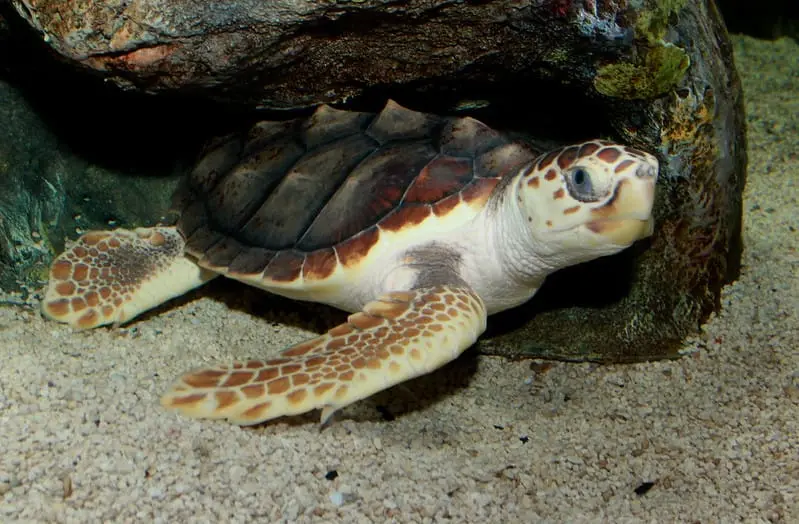
Scientific Name: Caretta caretta
It is one of the largest rigid-shelled species in the world — adults average 27 to 35 inches (89 cm) in length and weigh 176 to 440 pounds, but specimens as long as 83 inches (2.10 m) and weighing up to 1200 pounds (540 kg) have been recorded.
Compared to other species, the loggerhead has a relatively large head. It is carnivorous in the early stages of life, feeding primarily on gelatinous organisms such as salps and pyrosomes. As adults, they move closer to shore and begin to feed on crustaceans.
Hawks bill sea turtle
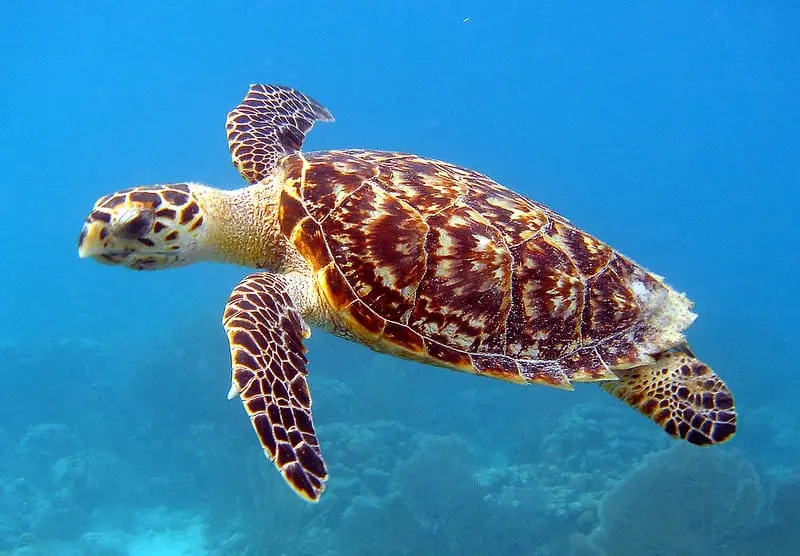
Scientific Name: Eretmochelys imbricata
The hawksbill turtle usually inhabits coral reefs and shallow coastal waters, but can occasionally be found in deep water. Adults typically reach between 23 and 39 inches in length and weigh between 160 and 220 pounds. However, the heaviest one ever found was 250 lbs (167 kg).
The hawksbill turtle has several features that distinguish it from other species: its head is elongated and conical, and it ends in a beak-shaped mouth that allows it to forage in the crevices of coral reefs. The shell or carapace of the hawksbill turtle has serrated edges on the back and is usually orange with an irregular combination of light and dark rays.
Although they are omnivorous, more than 70% of their diet consists of sea sponges, but they also feed on other invertebrates such as jellyfish, anemones, squid, and shrimp.
Green sea turtle
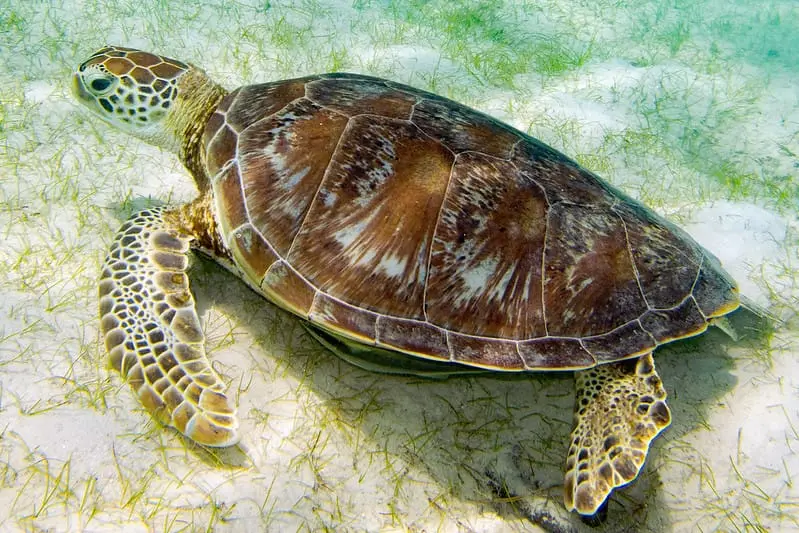
Scientific Name: Chelonia mydas
They usually inhabit coastal waters, islands, or bays where they are safe, and are rarely seen on the high seas. Unlike the hawksbill or loggerhead, the green turtle is primarily herbivorous, feeding primarily on sea grass.
Adults grow up to five feet long, and the average weights range from 150 to 418 pounds. Some exceptionally large ones have been found — the largest weighed 870 pounds and measured 60 inches.
The green turtle is so named because of the greenish color of its body fat, not because of its shell — the shell has different color patterns that change over time. Hatchlings, like other sea turtles, have black shells and a clear plastron. Juveniles' shells become dark brown or olive green, and adults' shells are all brown, spotted, or marbled with blended rays.
The ecology of this turtle changes drastically at each stage of its life: hatchlings are carnivorous and feed on fish eggs, mollusks, jellyfish, small invertebrates, sea sponges, algae, and crustaceans, and live in the open ocean. Juveniles and adults, on the other hand, are usually found feeding on seagrass near the shore.
Olive ridley sea turtle
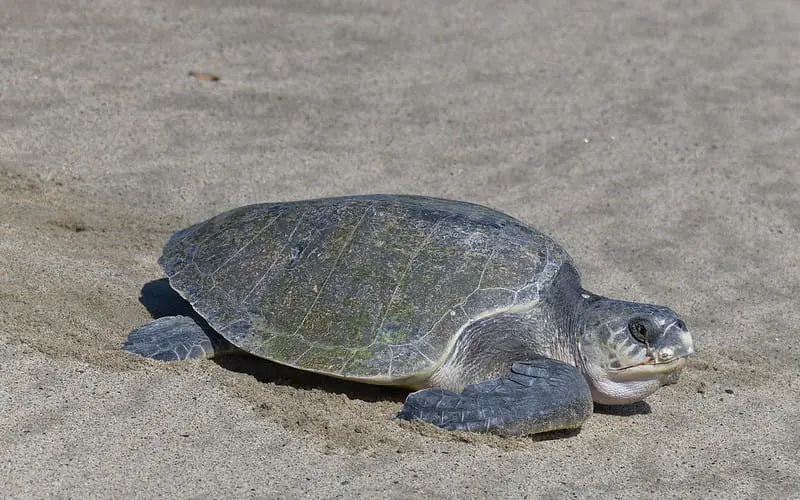
Scientific Name: Lepidochelys olivacea
They are mainly found near the coast and in shallow waters. Although it is the most abundant species, it is also endangered due to the difficulty in finding suitable nesting sites.
It is one of the smallest sea turtles in the world, growing to about 24 inches (61 cm) and rarely weighing more than 110 lbs (50 kg). Like the other species, the Olive Ridley is predominantly carnivorous, especially as a hatchling. It usually feeds on various types of invertebrates, but may occasionally feed on algae if no other food source is available.
Leatherback sea turtle
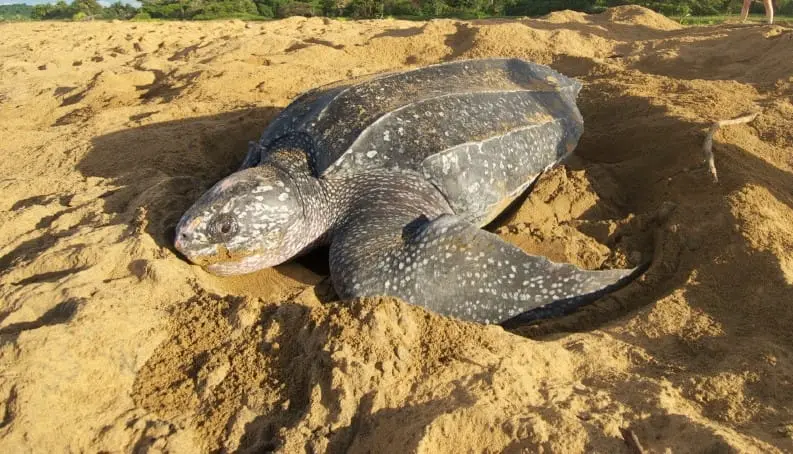
Scientific Name: Dermochelys coriacea
The Leatherback Turtle is the largest turtle in the world, reaching approximately 6 or 7 feet in length and weighing between 550 and 1,540 pounds.
Among sea turtles, the body of the leatherback turtle has the best hydrodynamics. The most notable feature of these turtles is the visible absence of a rigid carapace, which is replaced by one with a leather-like texture — hence both their common and scientific names. Their carapace is reduced to interspersed star-shaped ossicles. The largest of these ossicles are aligned protuberances that form undulating ridges called keels that run from the head to the tail of the animal.
Unlike the other species, the leatherback spends most of its time at sea, coming ashore only to lay its eggs. It is the only reptile with the ability to maintain its body temperature using heat generated by its own body. It spends only 0.1% of the day resting, and its constant swimming generates heat, and its layer of fat acts as a thermal insulator, allowing it to keep its body temperature much higher than the surrounding water.
Their diet consists mainly of jellyfish, which helps to control their populations. They can also occasionally feed on cephalopods and tunicates.
Threats and Conservation
Turtle hatchlings are very vulnerable: from the moment they leave their eggs, or even before, they must survive attacks from crabs, lizards, birds, dogs, marine predators and, of course, humans. Although a single turtle can lay many eggs, only 0.1% of the hatchlings survive to adulthood.
Only large tiger sharks and humans hunt adult turtles — it is estimated that approximately 35,000 turtles are killed each year for their meat, shell or eggs. With fishing becoming more intense, one of the biggest threats to these animals is bycatch and unlawful fishing, which kills thousands each year.
Habitat loss is also a problem: coastal development in nesting areas prevents females from laying eggs and makes it impossible for them to reproduce. In recent decades, human settlement and real estate speculation have degraded the marine and coastal environment, threatening these animals through the destruction of native vegetation, increased vehicle and boat traffic, and artificial lighting.
Moreover, the pollution of the oceans — mainly plastic bags, often mistaken for jellyfish, are ingested and significantly reduce the life span of turtles, which play a key role in the balance of the marine ecosystem: as they have a series of relationships and marine influences, they can also indicate the quality of the environment.
They are important regulators of various marine species such as jellyfish, algae, sponges and sea grasses. Without turtles, these populations could grow unsustainably, causing their ecosystem to become unbalanced, which could lead to various local extinctions and a decrease in diversity.
In a study of 102 turtles, more than 800 pieces of plastic were found in their stomachs. The most common items found were: cigarette butts, pieces of tires, various forms of plastic, and fishing materials.
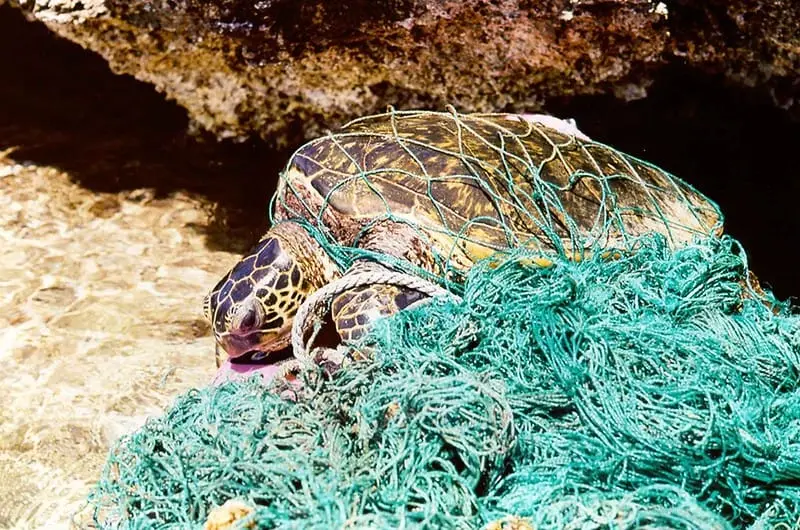
Other major concerns are climate change — which affects the number of males or females born — and oil spills in the oceans.
Turtles have been declining for decades. Of the seven existing species, all are endangered. Although they are widely distributed, their life cycle is long and complex, and their sexual maturation is very long, taking between 20 and 30 years.
In addition, their reproductive period has very large intervals, ranging from 1 to 3 years, which makes it even more difficult to increase their numbers. Since the turtles have a very wide range, their conservation requires international cooperation.
The Tamar Project has been developing conservation and education strategies for 30 years, but its success depends on well-coordinated national programs in conjunction with local communities and other non-governmental organizations.
One of the most important actions that can help conserve them (as well as all other marine species) is the conscious use of plastic: avoiding its use, disposing of it in the right places, and recycling it. Besides being mistaken for prey and ingested, turtles do not lay their eggs on dirty beaches, which further reduces their populations. Therefore, a small action that can make all the difference for these turtles is to clean the beaches and deposit all the garbage in an appropriate place.
Since they are very sensitive to sound and light, it is important during their spawning season to turn off nearby lights and noises so that the turtles or their hatchlings are not confused on their way back to the sea. This ensures that they are not disturbed and can follow their natural path without human interference. Therefore, in a balanced environment with little human intervention, the turtles live well and complete their life cycle in peace.
Read more:
Effects of temperature and demography on the phenology of loggerhead sea turtles in Brazil
Physiological effects of incidental capture and seasonality on juvenile green sea turtles
Olive ridley inter-nesting and post-nesting movements along the Brazilian coast and Atlantic Ocean
SUMÁRIO EXECUTIVO DO PLANO DE AÇÃO NACIONAL PARA A CONSERVAÇÃO DAS TARTARUGAS MARINHAS
Biologia, ecologia e conservação das tartarugas marinhas
